Evanston, Illinois
Evanston (/ˈɛvənstən/) is a city in the Chicagoland area. Located in Cook County, Illinois, it situated on the North Shore along Lake Michigan. Evanston is 12 miles (19 km) north of Downtown Chicago, bordered by Chicago to the south, Skokie to the west, Wilmette to the north, and Lake Michigan to the east. Incorporated in 1863, Evanston had a population of 74,486 as of 2010.[6] Evanston is home to Northwestern University, founded before the city's incorporation in 1855, and is one of the world's leading research universities.[7]
Evanston, Illinois | |
|---|---|
 View of downtown, at Sherman Avenue and Davis Street, looking south/south-east toward Chicago. | |
 Flag | |
| Nicknames: Heavenston, E-Town | |
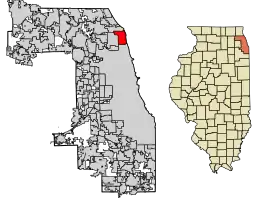 Location of Evanston in Cook County, Illinois. | |
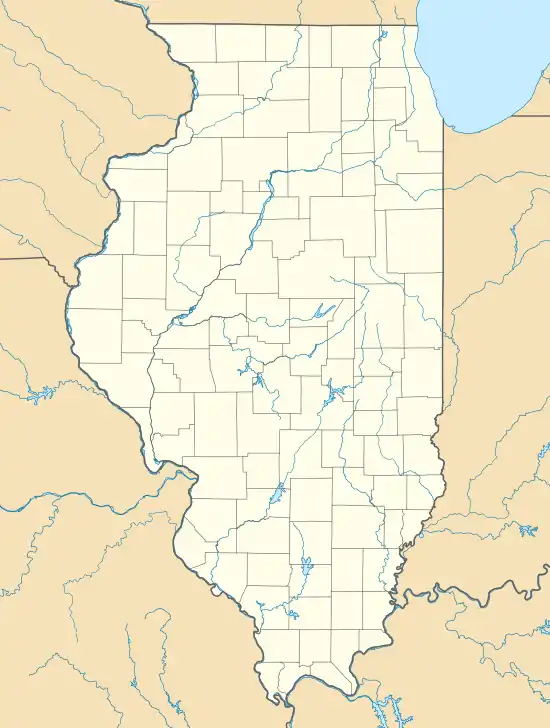 Evanston Location in the United States  Evanston Evanston (the United States) | |
| Coordinates: 42°02′47″N 87°41′41″W | |
| Country | |
| State | |
| County | Cook |
| Incorporated | 1872 |
| Government | |
| • Type | Council–manager |
| • Mayor | Steve Hagerty |
| • Budget | $304,494,806 (fiscal year: 2016)[1] |
| Area | |
| • Total | 7.80 sq mi (20.21 km2) |
| • Land | 7.78 sq mi (20.15 km2) |
| • Water | 0.02 sq mi (0.06 km2) 0.26% |
| Population (2010) | |
| • Total | 74,486 |
| • Estimate (2019)[3] | 73,473 |
| • Density | 9,445.04/sq mi (3,646.57/km2) |
| 0.33% increase from 2000 | |
| Demonym(s) | Evanstonian |
| Standard of living (2011) | |
| • Per capita income | $40,732 |
| • Median home value | $340,700 |
| Demographics (2010) | |
| • White | 65.6% |
| • Black | 18.1% |
| • Asian | 8.6% |
| • Other | 7.6% |
| • Hispanic (any race) | 9.0% |
| ZIP Codes | 60201–60204, 60208–60209 |
| Area codes | 847 & 224 |
| FIPS code | 17-24582 |
| GNIS ID | 2394709 |
| Website | cityofevanston |
Known for its socially liberal politics and ethnically diverse population, Evanston nears 90% support for Democratic presidential candidates and became one of the first cities to institute a reparations for slavery program.[8][9]
History
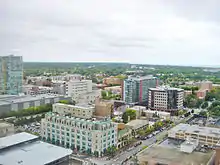
Prior to the 1830s, the area now occupied by Evanston was mainly uninhabited, consisting largely of wetlands and swampy forest. However, Potawatomi Native Americans used trails along higher lying ridges that ran in a general north–south direction through the area, and had at least some semi-permanent settlements along the trails.
French explorers referred to the general area as "Grosse Pointe" after a point of land jutting into Lake Michigan about 13 miles (21 km) north of the mouth of the Chicago River. After the first non-Native Americans settled in the area in 1836, the names "Grosse Point Territory" and "Gross Point voting district" were used through the 1830s and 1840s, although the territory had no defined boundaries.[10][11] The area remained only sparsely settled, supporting some farming and lumber activity on some of the higher ground, as well as a number of taverns or "hotels" along the ridge roads. Grosse Pointe itself steadily eroded into the lake during this period.
In 1850, a township called Ridgeville was organized, extending from Graceland Cemetery in Chicago to the southern edge of the Ouilmette Reservation, along what is now Central Street, and from Lake Michigan to Western Avenue in Chicago. The 1850 census shows a few hundred settlers in this township,[11] and a post office with the name of Ridgeville was established at one of the taverns. However, no municipality yet existed.
In 1851, a group of Methodist business leaders founded Northwestern University and Garrett Biblical Institute. Unable to find available land on the north shore up to Lake Forest, the committee was ready to purchase farmland to the west of the city when Orrington Lunt insisted on one final visit to the present location.[12] They chose a bluffed and wooded site along the lake as Northwestern's home, purchasing several hundred acres of land from Dr. John Foster, a Chicago farm owner. In 1854, the founders of Northwestern submitted to the county judge their plans for a city to be named Evanston after John Evans,[13] one of their leaders. In 1857, the request was granted.[14] The township of Evanston was split off from Ridgeville Township; at approximately the same time, that portion of Ridgeville south of Devon Avenue was organized as Lake View Township.[15] The nine founders, including John Evans, Orrington Lunt, and Andrew Brown, hoped their university would attain high standards of intellectual excellence. Today these hopes have been fulfilled, as Northwestern consistently ranks with the best of the nation's universities.
Evanston was formally incorporated as a town on December 29, 1863, but declined in 1869 to become a city despite the Illinois legislature passing a bill for that purpose. Evanston expanded after the Civil War with the annexation of the village of North Evanston. Finally, in early 1892, following the annexation of the village of South Evanston, voters elected to organize as a city.[16] The 1892 boundaries are largely those that exist today.
During the 1960s, Northwestern University changed the city's shoreline by adding a 74-acre (30 ha) lakefill.[17]
In 1939, Evanston hosted the first NCAA basketball championship final at Northwestern University's Patten Gymnasium.[18]
In August 1954, Evanston hosted the second assembly of the World Council of Churches, still the only WCC assembly to have been held in the United States. President Dwight Eisenhower welcomed the delegates, and Dag Hammarskjöld, secretary-general of the United Nations, delivered an important address entitled "An instrument of faith".[19]
Evanston first received power in April 1893. Many people lined the streets on Emerson St. where the first appearance of street lights were lined and turned on. Today, the city is home to Northwestern University, Music Institute of Chicago, and other educational institutions, as well as headquarters of Alpha Phi International women's fraternity, Rotary International, the National Merit Scholarship Corporation, the National Lekotek Center, the Sigma Alpha Epsilon fraternity, the Sigma Chi fraternity and the Woman's Christian Temperance Union.
Evanston is the birthplace of Tinkertoys, and is the one of the locations having originated the ice cream sundae.[20] Evanston was the home of the Clayton Mark and Company, which for many years supplied the most jobs.[21]
Evanston was a dry community from 1858 until 1972, when the City Council voted to allow restaurants and hotels to serve liquor on their premises. In 1984, the Council voted to allow retail liquor outlets within the city limits.[22]
Geography
According to the 2010 census, Evanston has a total area of 7.802 square miles (20.21 km2), of which 7.78 square miles (20.15 km2) (or 99.72%) is land and 0.022 square miles (0.06 km2) (or 0.28%) is water.[23]
Demographics
| Historical population | |||
|---|---|---|---|
| Census | Pop. | %± | |
| 1880 | 4,400 | — | |
| 1890 | 9,000 | 104.5% | |
| 1900 | 19,259 | 114.0% | |
| 1910 | 24,978 | 29.7% | |
| 1920 | 37,234 | 49.1% | |
| 1930 | 63,338 | 70.1% | |
| 1940 | 65,389 | 3.2% | |
| 1950 | 73,641 | 12.6% | |
| 1960 | 79,263 | 7.6% | |
| 1970 | 79,808 | 0.7% | |
| 1980 | 73,706 | −7.6% | |
| 1990 | 73,233 | −0.6% | |
| 2000 | 74,239 | 1.4% | |
| 2010 | 74,486 | 0.3% | |
| 2019 (est.) | 73,473 | [3] | −1.4% |
As of the census of 2010, there were 74,486 people (up from 74,239 at the 2000 census), 30,047 households, and 15,621 families residing in the city. The population density was 9,574.0 people per square mile (3,687.4/km2). There were 33,181 housing units at an average density of 4,264.9 per square mile (1,642.6/km2). The 2010 census showed that Evanston is ethnically mixed with the following breakdown in population: 65.6% White, 18.1% Black or African American, 0.2% American Indian or Alaska Native, 8.6% Asian, 0.02% Native Hawaiian or other Pacific Islander, 3.6% some other race, and 3.8% from two or more races. 9.0% were Hispanic or Latino of any race.[6]
There were 30,047 households, out of which 26.1% had children under the age of 18 living with them, 39.8% were headed by married couples living together, 9.7% had a female householder with no husband present, and 48.0% were non-families. 37.5% of all households were made up of individuals, and 10.5% were someone living alone who was 65 years of age or older. The average household size was 2.25, and the average family size was 3.05.[6]
The median age was 34.3 years, with 19.3% under the age of 18, 16.8% from 18 to 24, 27.8% from 25 to 44, 24.0% from 45 to 64, and 12.2% who were 65 years of age or older. For every 100 females, there were 91.0 males. For every 100 females age 18 and over, there were 88.0 males.[6]
As of 2011, the estimated median income for a household in the city was $60,033, and the median income for a family was $102,706. Male full-time workers had a median income of $66,106 versus $52,727 for females. The per capita income for the city was $40,732. About 6.4% of families and 12.1% of the population were below the poverty line, including 14.1% of those under age 18 and 6.5% of those age 65 or over.[4]
12.3% of Evanston's 9,259 businesses are Black owned.[25]
Government and politics
The City of Evanston became sister cities with the Dnieprovsky District of the City of Kyiv, Ukraine in 1988, and sister cities with Belize City, Belize in 1992.
Evanston has a council-manager system of government and is divided into nine wards, each of which is represented by an Alderman, or member of the Evanston City Council. Businessman Steve Hagerty was elected mayor in April 2017, replacing Elizabeth Tisdahl, who had served since 2009.[26] Hagerty, who won election by a margin of only 111 votes,[27] was sworn into office on May 8.[28]
Evanston was heavily Republican in voter identification from the time of the Civil War up to the 1960s. Nixon carried Evanston in the 1968 presidential election.[29] The city began trending Democratic in the 1960s, though it did not elect a Democratic mayor until 1993. The city swung particularly heavily to the Democrats in the 1990s, along with many other Chicago suburbs, and now almost exclusively identifies with Democrats in elections on all levels of government.
Lorraine H. Morton
Lorraine Hairston Morton (December 8, 1918 – September 8, 2018) was Evanston's longest serving mayor. In 1993, Morton ran for mayor of Evanston under the campaign slogan "Morton for Mayor," which accompanied images of trains and lists of people who were "on board" with her campaign. After a run-off election against Ann Rainey, alderman of Evanston's Eighth Ward, Morton was elected Evanston's first African-American and first Democratic mayor.
Morton was in office for sixteen years (until 2009), becoming Evanston's longest-serving mayor. During her long mayoral tenure, Morton attempted to improve the town-gown relationship between Northwestern University and the greater population of Evanston. She was able to form a close friendship with Northwestern University president Henry Bienen and ameliorate the tension between Evanston and the University given her status as both the Mayor of Evanston and a proud alumna of Northwestern.
Mayor Morton also worked with local community leaders and churches to create a safe zone and a ("time out") period of time that gangs would call a truce. During this time, (Friday and Saturday nights, a time of would-be heightened gang activity) the community, including gang members were invited to play basketball at Evanston's Robert Crown Center. Morton would often be seen cheering from the sidelines. Evanston's civic center was renamed for Morton at the time of her retirement in 2009 and is now known as the Lorraine H. Morton Civic Center. In addition to being Evanston's first African-American, Democratic, and longest-serving mayor, Morton is also notable for spearheading the desegregation of Evanston's public schools as a teacher and school principal.
Recent election results
In the 2012 presidential election, Democratic incumbent Barack Obama won 85% of Evanston's vote, compared to 13% for Republican challenger Mitt Romney.[30] In the 2016 Democratic primary, Hillary Clinton received 54% of the votes of Evanston Democrats to Bernie Sanders' 45%.[31] During that year's general election, Clinton won 87% of the vote in Evanston, while Republican Donald Trump received just 7%.[32] Evanston's turnout for presidential elections has grown steadily since 2004, with 80% of registered voters voting in the 2016 general election.[33]
Nicknames
- Early after its founding, because of its strong Methodist influence, and its attempt to impose moral rigor, Evanston was called "Heavenston".[34]
- In the early 20th century Evanston was called "The City of Churches".[35]
- The varied works of numerous prominent architects, and many prominent mansions, especially near the lakefront, gave the town by the 1920s the sobriquet "The City of Homes",[34][36] a fact often touted by local real estate agents.[37] Use of the phrase has been attributed to a 1924 speech at the local Kiwanis club.[38]
- Since the late 20th century, because of Evanston's activism and often left-of-center politics, it is sometimes humorously (or sarcastically) referred to as "The People's Republic of Evanston".[39][40][41]
- The eastern border of the adjacent village of Skokie that falls within Evanston township schools and 60203 zip code is called "Skevanston", a portmanteau of both names.
Education
High school
Most of Evanston (and a small part of the village of Skokie) is within the boundaries of Evanston Township High School District 202.[42] The school district has a single high school, Evanston Township High School, with an enrollment of just over 4,000, covering grades 9 through 12.
Primary schools
Evanston-Skokie Community Consolidated School District 65, covering all of Evanston and a small part of Skokie, provides primary education from pre-kindergarten through grade 8. The district has ten elementary schools (kindergarten through fifth grade), three middle schools (grades 6 through 8), two magnet schools (K through 8), two special schools or centers, and an early childhood school. Dr. Paul Goren is the Superintendent of Schools.
Private schools
Private schools located in Evanston, Illinois include:
- Beacon Academy, a Montessori high school
- Chiaravalle Montessori School, a Montessori school for children ages 2–14
- Midwest Montessori School
- Pope John XXIII School, a Catholic school serving children pre-kindergarten through eighth grade. The school dates back to 1886 with the establishment of separate schools serving St. Nicholas and St. Mary's parishes in Evanston. The original St. Nicholas School was in the building now called the Annex. The main school building was built in 1954. In 1986 the two parish schools consolidated and the new school was renamed Pope John XXIII School.[43]
- Roycemore School
- St. Athanasius School, a Catholic school for children from junior kindergarten through eighth grade.
Library
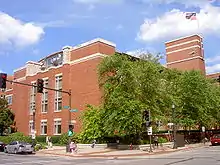
The Evanston Public Library was established in 1873,[44] and has three branches as of 2013.[45] Heather Norborg currently heads the Adult Services Department of the Library.
Tertiary
In 2006, National-Louis University closed its former main site, which had 6.5 acres (2.6 ha) of land, with about 33% in Evanston; the majority of the land was in Wilmette.[46]
University
Founded in 1855, Evanston is home to Northwestern University, one of the nation's leading research universities. Located along Lake Michigan, Northwestern's campus spans 240 acres with an estimated 250 buildings.
Transportation
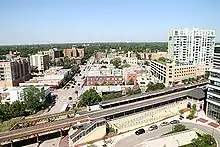
Evanston's growth occurred largely because of its accessibility from Chicago by rail. The Northwestern founders did not finalize their commitment to siting the university there until they were assured the Chicago & Milwaukee Railway line would run there. C&M trains began stopping in Evanston in 1855.[47] Evanston later experienced rapid growth as one of the first streetcar suburbs. The North Shore Line, the interurban railroad that gave the area its nickname, ran through Evanston and continued to Waukegan and Milwaukee.
The city is still connected to Chicago by rail transit. The CTA's Purple Line, part of the Chicago 'L' system, runs through Evanston. From its terminal at Howard in Chicago, the line heads north to the South Boulevard, Main, Dempster, Davis, Foster, Noyes, and Central stations, before terminating at the Linden station in Wilmette, Illinois. Metra's Union Pacific/North Line also serves Evanston, with stations at Main Street, Davis Street and Central Street, the first two being adjacent to Purple Line stations. The CTA's Yellow Line also runs through the city, though it does not stop there. Evanston is served by six CTA bus routes as well as four Pace bus routes.
Automobile routes from Chicago to Evanston include Lake Shore Drive, the Edens Expressway (I-94), and McCormick Boulevard, although the first two of those do not extend to Evanston itself and require driving through Rogers Park (via Sheridan Road or Ridge Avenue) and Skokie, respectively. The main routes from the north are the Edens, Green Bay Road, and Sheridan Road. Active modes of transportation include miles of sidewalks and bicycle lanes.
Economy
Companies based in Evanston include ZS Associates.
Top employers
As of 2015, according to the State of Illinois Dept Commerce and Economic Opportunity and Individual Employers,[48] the top employers in the city are:
| # | Employer | # of Employees |
|---|---|---|
| 1 | Northwestern University | 9,471 |
| 2 | NorthShore University HealthSystem | 3,727 |
| 3 | Evanston-Skokie School District 65 | 1,600 |
| 4 | Saint Francis Hospital | 1,272 |
| 5 | City of Evanston | 918 |
| 6 | Presbyterian Homes | 602 |
| 7 | Rotary International | 525 |
| 8 | Evanston Township High School District 202 | 520 |
| 9 | Jewel/Osco | 480 |
| 10 | C.E. Niehoff & Co. | 450 |
Commercial districts
Once the home of one of the first Marshall Field's[49][50] and Sears stores in suburbia, Evanston has several shopping areas:
- Downtown - centered around the Davis Street Metra and "L" stops,[51] Evanston's downtown adjoins Northwestern University. There are over 300 businesses,[52] several high-rise office and residential buildings, three traditional low-rise shopping areas, an 18-screen movie theater, and over 85 restaurants. It is roughly bordered by Emerson Street to the north, Dempster Street to the south, Ridge Avenue to the west, and the Lake to the east.
- Central Street - actually several shopping districts linked along the northernmost of the city's principal east–west arteries,[53][54] with the most active clustered around the Central Street Metra station and characterized by specialty shops and restaurants.[55][56][57]
- Dempster Street - just off the Dempster "L" stop; over 60 shops.[58][59]
- Main Street - approximately 3 blocks of mostly independent boutiques and restaurants[60] abutting both a CTA and Metra stop. Since 1917,[61] the neighborhood has been home to the South Branch[62] of the Evanston Public Library. After the original branch closed in February 2011 due to budgetary concerns, the Chicago Ave./Main St. Branch was opened down the street in January 2013, replacing an interim volunteer library that had been operated in that location by the Evanston Public Library Friends.[63] The neighborhood is also home to the Evanston Arts Depot.[64]
- Howard Street - Howard Street forms the southern border between Evanston and the City of Chicago. The Howard Street CTA station is a transfer point between the Red, Purple, and Yellow line trains as well as several CTA and PACE bus routes.
- Chicago Avenue - not a separate shopping district per se, this extension of what is called Clark Street in Chicago runs parallel to the rail lines and is the principal north–south artery in Evanston from Howard Street north to its terminus at Northwestern University. Chicago Avenue connects the Main Street, Dempster Street, and Downtown shopping districts.
- Noyes - Bordering the Noyes "L" stop with around a dozen restaurants, dry-cleaners and convenience stores.
Finance
- First Bank & Trust, an independent community and commercial financial institution, is headquartered in Evanston with four locations around the city.
- Magnetar Capital, a hedge fund based in Evanston, was ranked #4 among hedge funds worldwide by Institutional Investor/Alpha magazine in 2015.[65]
Health care
Two hospitals are located within Evanston's city limits:
University-city relations
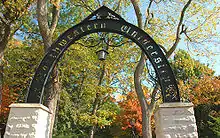
A perennial debate in Evanston is the issue of Northwestern University's status as a tax-exempt institution.[66] In the founding charter of Northwestern University, signed in 1851, the state granted the school an exemption from paying property taxes, and unlike other well-off private universities with statutory exemptions,[67] it provides its own police services, but not firefighter/paramedic services. It pays water, sewer, communications, real property transfer taxes, and building permit fees, but not property taxes. Northwestern does not make Payments in Lieu of Taxes for the real estate it removes from property tax rolls.
Its backers, like former Evanston mayor and Northwestern alumna Lorraine H. Morton, contend that the benefits of having an elite research institution justify Northwestern's tax status.[68] These supporters highlight the fact that Northwestern University is the largest employer in Evanston,[69] and that its students and faculty constitute a large consumer base for Evanston businesses. This controversy was revived in 2003 when the university purchased an eight-story office building downtown, removing it from the tax rolls. An advisory referendum put on the April elections ballot, dubbed by supporters as a "Fair Share Initiative", received a majority, but was not passed into ordinance by the City Council.
During the tenure of Elizabeth Tisdahl as mayor, relationships between the University and Evanston improved. Upon arriving at Northwestern in 2009 president Morton O. Schapiro forged a strong working relationship with Tishdal;[70] in 2015, two announced that Northwestern would begin to donate $1 million annually to benefit city services and programs.[71]
Notable people
Local media
- The Daily Northwestern, the student newspaper at Northwestern University
- The Evanston Review, subscription weekly newspaper, part of Pioneer Press
- The Evanston Roundtable, free biweekly newspaper
- The Evanston Sentinel, a free weekly African-American newspaper
- Evanston Now, an online newspaper and community website
Use as film location
Evanston's variety of housing and commercial districts, combined with easy access to Chicago, make it a popular filming location. Evanston as of December 2008 is listed as a filming location for 65 different films, notably those of John Hughes.[72] Much of the 1984 film Sixteen Candles was filmed in and around Evanston,[73] the 1988 movie She's Having a Baby, as was the 1989 film Uncle Buck,[74] the 1993 film Dennis the Menace,[75] and the 1997 film Home Alone 3.[76] A number of scenes from the 1986 Garry Marshall film Nothing in Common were filmed on the Northwestern University campus and Evanston's lakeshore.[77] Although not filmed there, the 2004 film Mean Girls is set in the Chicago suburbs, and makes several references to the area. The movie's screenwriter and co-star, Tina Fey, had worked at the Evanston YMCA when starting her comedy career. In the 2003 film Cheaper by the Dozen, the family moves to Evanston.[78] Additionally, the baseball movie Rookie of the Year, featuring Gary Busey and Thomas Ian Nicholas, was partially shot at Haven Middle School.[79] The 2015 ABC Family reality series Becoming Us was filmed in Evanston.
In The Princess Bride, according to IMDb, the screenplay says that the boy and his grandfather live in Evanston.[80] This was also stated by Mandy Patinkin in a behind-the-scenes interview.[81] The story's author, William Goldman, was born in Chicago and grew up in Highland Park a little more than ten miles north of Evanston.
Sustainability
Evanston has gained recognition and reputation for efforts related to sustainability, including those by government, citizens, and institutions. In 2015, the city was named the World Wildlife Fund's Earth Hour Capital after competing against cities including Seattle and Cleveland. In 2016, Evanston was again a finalist in the competition.[82]
Climate Action Plan
In October 2006, the city voted to sign the United States Conference of Mayors Climate Protection Agreement,[83] and a number of citizen task forces convened to develop a plan to reduce the city's carbon footprint.[84] The Evanston Climate Action Plan ("ECAP"), accepted by the City Council in November 2008, suggested over 200 strategies to make Evanston more sustainable, principally by reducing carbon emissions associated with transportation, buildings, energy sources, waste, and food production.[85][86] In June 2011, the United States Conference of Mayors awarded Evanston first place in the small city category of the Mayors' Climate Protection Awards, based largely on the city's use of the ECAP, which the city asserts has reduced emissions by 24,000 metric tons per year.[87][88] On September 15, 2011, Wal-Mart presented Mayor Tisdahl with a $15,000 award in recognition of the honor, which the mayor donated to Citizens' Greener Evanston.[89]
Points of interest
References
- "Fiscal Year 2016 Adopted Budget" (PDF). City of Evanston. January 1, 2016. Archived from the original (PDF) on September 27, 2016. Retrieved September 24, 2016.
- "2019 U.S. Gazetteer Files". United States Census Bureau. Retrieved July 14, 2020.
- "Population and Housing Unit Estimates". United States Census Bureau. May 24, 2020. Retrieved May 27, 2020.
- "Selected Economic Characteristics: 2011 American Community Survey 1-Year Estimates (DP03): Evanston city, Illinois". U.S. Census Bureau, American Factfinder. Archived from the original on February 12, 2020. Retrieved February 11, 2013.
- "Selected Housing Characteristics: 2011 American Community Survey 1-Year Estimates (DP03): Evanston city, Illinois". U.S. Census Bureau, American Factfinder. Archived from the original on February 12, 2020. Retrieved February 11, 2013.
- "Profile of General Population and Housing Characteristics: 2010 Demographic Profile Data (DP-1): Evanston city, Illinois". U.S. Census Bureau, American Factfinder. Archived from the original on February 12, 2020. Retrieved February 11, 2013.
- inc"History and Demographics | City of Evanston". www.cityofevanston.org. Retrieved June 15, 2020.
- Winck, Ben (November 11, 2016). "Less than 10 percent of Evanston voters cast ballot for Donald Trump". The Daily Northwestern. Retrieved June 15, 2020.
- Armus, Teo. "A Chicago suburb wants to give reparations to black residents. Its funding source? A tax on marijuana". The Washington Post. Retrieved June 15, 2020.
- Illinois State Historical Society; Currey, Seymour (1909). "Chicago's North Shore". Transactions of the Illinois State Historical Society for the year 1908. Springfield, Illinois: Illinois State Historical Library. pp. 101–109. Retrieved August 26, 2010.
- "This is Evanston," League of Women Voters of Evanston, 2000, ISBN 0-9676994-0-1 "Archived copy" (PDF). Archived from the original (PDF) on March 25, 2009. Retrieved February 6, 2016.CS1 maint: archived copy as title (link) pp. 8–18
- Willard, Frances (1891). A Classic Town: The Story of Evanston (1st ed.). Woman's Temperance Publishing Association. p. 19. Retrieved February 17, 2006.
- Gannett, Henry (1905). The Origin of Certain Place Names in the United States. Govt. Print. Off. pp. 122.
- City of Evanston. "City of Evanston - About Evanston - History". Archived from the original on March 25, 2008. Retrieved December 13, 2008.
- Goodspeed Historical Association (1909). Weston A. Goodspeed; Daniel D. Healy (eds.). History of Cook County, Illinois; being a general survey of Cook County. 2. Chicago, Illinois. pp. 250–260. ISBN 9780608368948. Retrieved August 26, 2010.
- Newton Bateman; Paul Selby, eds. (1917). "Evanston". Historical Encyclopedia of Illinois. 1. Chicago: Munsell Publishing Co. p. 160. Retrieved December 14, 2008.
- "The James Roscoe Miller Campus". Retrieved February 23, 2013.
- "Giant Oregon five defeats Ohio for U.S. title, 46–33". Milwaukee Sentinel. Associated Press. March 28, 1939. p. 12.
- Hjelm, Norman A. (September 14, 2004). "Evanston After Fifty Years". World Council of Churches. Archived from the original on July 4, 2008. Retrieved December 18, 2008.
- History Channel - Modern Marvels - "Ice Cream Tech" - (2008)
- "Clayton Mark Products Used Throughout the World". Evansbriar Review. May 7, 1953.
- Foerstner, Abigail. "Evanston liquor store to close door on era." Chicago Tribune. July 6, 1984. p. NS-1.
- "G001 - Geographic Identifiers - 2010 Census Summary File 1". United States Census Bureau. Archived from the original on February 13, 2020. Retrieved December 27, 2015.
- "Census of Population and Housing". Census.gov. Retrieved June 4, 2016.
- "Evanston (city) QuickFacts from the US Census Bureau". quickfacts.census.gov. Archived from the original on July 4, 2012. Retrieved March 1, 2016.
- Smith, Bill (April 8, 2017). "Hagerty lead shrinks as late-vote count continues". Evanston Now. Retrieved April 13, 2017.
- "Suburban Cook County Election Results April 04, 2017 Consolidated General Election". Cook County Clerk. Retrieved April 14, 2017.
- Bookwalter, Genevieve. "Candidate concedes in Evanston mayoral race". chicagotribune.com. Retrieved April 14, 2017.
- "Affluent Settled Evanston, Illinois". Time. March 15, 1971. Retrieved September 18, 2011.
- "Suburban Cook County Election Results, November 06, 2012 Presidential General Election". Cook County Clerk. Retrieved April 14, 2017.
- "Suburban Cook County Election Results, March 15, 2016 Presidential Primary Election". Cook County Clerk. Retrieved October 25, 2017.
- "Suburban Cook County Election Results, November 08, 2016 Presidential General Election". Cook County Clerk. Retrieved April 14, 2017.
- "Post-Election Report 2016" (PDF). Cook County Clerk. Archived from the original (PDF) on April 15, 2017. Retrieved April 14, 2017.
- "A Brief History of Evanston". Evanston Public Library. Retrieved January 8, 2009.
- "Evanston, Ill.". The Encyclopedia Americana. X. 1918. p. 593. Retrieved January 8, 2009.
It is really a residential suburb of Chicago, and called "City of Churches."
- Green, Caryn (January 2009). "Welcome to Heavenston". North Shore Magazine. Retrieved January 8, 2009.
- e.g., "Evanston Real Estate - Evanston MLS". Baird & Warner. 2007. Retrieved January 8, 2009.
- "Evanston CM" (PDF). City of Evanston (advertisement for City Manager). January 2009. Archived from the original (PDF) on July 18, 2014. Retrieved January 8, 2009.
- Reed, Robert (November 26, 2008). "Surprise! This Bank Refuses Fed Bailout". HuffPost.
- Traffic Guy (June 11, 2008). "The Traffic Guy Hears". Evanston Roundtable. Archived from the original on December 12, 2008. Retrieved January 8, 2009.
- "CSNA Mayoral Forum Q. #9 (gentrification) & Q.10 (People's Republic of Evanston) / Central Street Neighbors Association". March 23, 2009. Archived from the original on July 7, 2012. Retrieved March 26, 2009.
- "EVANSTON TOWNSHIP HIGH SCHOOL 2018-19 School Profile" (PDF). Evanston Township High School. Retrieved July 17, 2019.
- "Pope John XXIII School - Our History". Pope John XXIII School. Retrieved April 4, 2014.
- "Library Anniversaries", Illinois Libraries, Illinois Library Extension Division, 5 (4): 61, October 1923
- Fisher, Jennifer (January 24, 2013). "Library Branch Returns to South Evanston". EvanstonPatch. Retrieved June 10, 2013.
- Brachear, Manya A. (May 7, 2004). "National-Louis to move campus". Chicago Tribune. Retrieved July 31, 2019.
- "History of Northwestern University Library". Northwestern University Library. March 3, 2001. Archived from the original on July 9, 2011. Retrieved December 14, 2008.
- "City of Evanston - Major Employers in Evanston" (PDF). Archived from the original (PDF) on October 18, 2016.
- Newman, Scott A. (May 11, 2006). "Jazz Age Chicago--Marshall Field & Co". Archived from the original on September 27, 2011. Retrieved December 13, 2008.
- "Evanston Galleria - Building History". Retrieved December 14, 2008.
- "Where Chicago and the North Shore Meet - Downtown Evanston Gift Card - Downtown Evanston". www.downtownevanston.org.
- "消費者金融でお金を借りる?? - 消費者金融について書いています。". www.evmark.org. Archived from the original on September 3, 2018. Retrieved December 31, 2018.
- "About Central Street - Central Street Neighbors Association". Archived from the original on July 21, 2012. Retrieved December 13, 2008.
- "Central Street Business Association - Home". Retrieved December 13, 2008.
- Hartong, Jason (June 11, 2008). "Evanston's Central Street". Chicago North Shore Home & Beyond. Archived from the original on July 8, 2011. Retrieved December 13, 2008.
- "Our Evanston- Green Bay Road Office". Koenig & Strey. Archived from the original on December 5, 2008. Retrieved December 13, 2008.
- The Lakota Group (April 12, 2007). "Central Street Master Plan Council Handout April 12, 2007" (PDF). City of Evanston. Archived from the original (PDF) on March 25, 2009. Retrieved December 13, 2008.
- "Chicago/Dempster Merchants Association". Retrieved December 16, 2008.
- Aeh, Kevin (July 9, 2008). "3.6 hours in Evanston". Time Out Chicago. Archived from the original on February 9, 2009. Retrieved December 16, 2008.
- "Main Street Station - Evanston with a Heart". Carfree Chicago. Retrieved June 10, 2013.
- Duffer, Robert (February 24, 2010). "Book place: Evanston public library south branch". Chicago Tribune. Retrieved September 6, 2010.
- "South Branch". Evanston Public Library. Retrieved September 6, 2010.
- "Library Branch Returns to South Evanston". Evanston Patch. Retrieved June 10, 2013.
- "Evanston Arts Depot - Cultural Arts Center". 2006. Archived from the original on February 17, 2009. Retrieved December 13, 2008.
- Taub, Stephen. "The Hedge Fund Report Card" (PDF). Institutional Investor's Alpha.
- https://www.northwestern.edu/controller/tax/tax-exempt-status.html
- "Harvard Will Pay More To Cambridge in Accord". The New York Times. November 28, 1990. Retrieved May 2, 2010.
- Allen, J Linn (October 22, 2000). "Nu Celebrates Landmark Birthday". Chicago Tribune.
- Evanston, Illinois#Top employers
- Harris, Melissa. "Evanston, Northwestern tensions crumble after cookie gambit". chicagotribune.com. Retrieved May 4, 2019.
- Seidenberg, Bob. "Evanston, Northwestern announce details of $1 million donation". chicagotribune.com. Retrieved May 4, 2019.
- "Titles with locations including Evanston, Illinois, USA". IMDb. Retrieved December 13, 2008.
- "Sixteen Candles (1984)". Retrieved December 14, 2008.
- "Uncle Buck (1989)".
- "Dennis the Menace (1993)".
- "Home Alone 3 (1997)".
- "Nothing in Common (1986)".
- "'Mean' streets? Teens say Evanston not that bad Harsh high school movie supposedly set in north suburb". May 4, 2004. Archived from the original on November 5, 2012. Cite journal requires
|journal=(help) - Rookie of the Year at IMDb
- "The Princess Bride (1987)".
- Johnny Cade (August 20, 2014). "behind the scenes PRINCESS BRIDE part 1" – via YouTube.
- "Evanston Selected as US Earth Hour City Challenge Finalist for Second Straight Year". City of Evanston. May 25, 2016. Archived from the original on March 29, 2016. Retrieved September 24, 2016.
- "Mayors Climate Protection Center". United States Conference of Mayors. Archived from the original on February 18, 2010. Retrieved February 18, 2010.
- "City of Evanston - Office of Sustainability > Warming". City of Evanston. Archived from the original on April 21, 2009. Retrieved February 18, 2010.
- "City of Evanston, Evanston Climate Action Plan" (PDF). Archived from the original (PDF) on March 6, 2009.
- "ECAP - Citizens for a Greener Evanston". Archived from the original on July 26, 2011. Retrieved February 18, 2010.
- "Evanston Wins National Award for Climate Protection". Central Street Neighbors Association. June 17, 2011. Retrieved June 17, 2011.
- "Houston (TX) and Evanston (IL) win First Place Honors for Local Climate Protection Efforts" (PDF). The United States Conference of Mayors. June 17, 2011. Archived from the original (PDF) on June 21, 2011. Retrieved June 17, 2011.
- Smith, Bill (September 16, 2011). "Mayor donates climate award to ecology group". Evanston Now. Retrieved January 25, 2019.
Further reading
- "Evanston". Illinois State Gazetteer and Business Directory, for the Years 1864–5. Chicago: J.C.W. Bailey. 1864. OCLC 6867103. OL 7082742M.
- Barr, Mary (2014). Friends Disappear: The Battle for Racial Equality in Evanston.
External links
| Wikimedia Commons has media related to Evanston, Illinois. |
| Wikivoyage has a travel guide for Evanston. |
| Wikisource has the text of the 1911 Encyclopædia Britannica article Evanston. |


